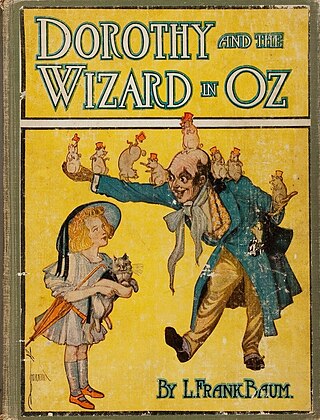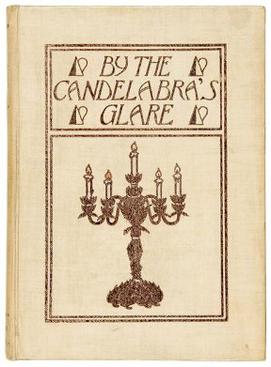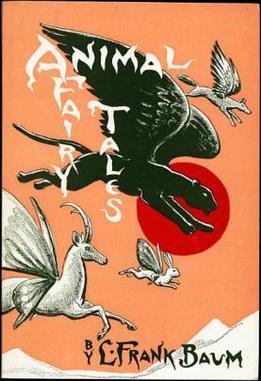Related Research Articles

Aberdeen is a city in and the county seat of Brown County, South Dakota, United States, located approximately 125 miles (201 km) northeast of Pierre. The population was 28,495 at the 2020 census, making it the third most populous city in the state after Sioux Falls and Rapid City. Aberdeen is home of Northern State University.

Lyman Frank Baum was an American author best known for his children's fantasy books, particularly The Wonderful Wizard of Oz, part of a series. In addition to the 14 Oz books, Baum penned 41 other novels, 83 short stories, over 200 poems, and at least 42 scripts. He made numerous attempts to bring his works to the stage and screen; the 1939 adaptation of the first Oz book became a landmark of 20th-century cinema.

The Wonderful Wizard of Oz is a 1900 children's novel written by author L. Frank Baum and illustrated by W. W. Denslow. It is the first novel in the Oz series of books. A Kansas farm girl named Dorothy ends up in the magical Land of Oz after she and her pet dog Toto are swept away from their home by a cyclone. Upon her arrival in the magical world of Oz, she learns she cannot return home until she has destroyed the Wicked Witch of the West.

Sitting Bull was a Hunkpapa Lakota leader who led his people during years of resistance against United States government policies. He was killed by Indian agency police on the Standing Rock Indian Reservation during an attempt to arrest him, at a time when authorities feared that he would join the Ghost Dance movement.

The yellow brick road is a central element in the 1900 children's novel The Wonderful Wizard of Oz by American author L. Frank Baum. The road also appears in the several sequel Oz books such as The Marvelous Land of Oz (1904) and The Patchwork Girl of Oz (1913).

The Wounded Knee Massacre, also known as the Battle of Wounded Knee, was the deadliest mass shooting in American history, involving nearly three hundred Lakota people shot and killed by soldiers of the United States Army. The massacre, part of what the U.S. military called the Pine Ridge Campaign, occurred on December 29, 1890, near Wounded Knee Creek on the Lakota Pine Ridge Indian Reservation in South Dakota, following a botched attempt to disarm the Lakota camp. The previous day, a detachment of the U.S. 7th Cavalry Regiment commanded by Major Samuel M. Whitside approached Spotted Elk's band of Miniconjou Lakota and 38 Hunkpapa Lakota near Porcupine Butte and escorted them five miles westward to Wounded Knee Creek, where they made camp. The remainder of the 7th Cavalry Regiment, led by Colonel James W. Forsyth, arrived and surrounded the encampment. The regiment was supported by a battery of four Hotchkiss mountain guns. The Army was catering to the anxiety of settlers who called the conflict the Messiah War and were worried the Ghost Dance signified a potentially dangerous Sioux resurgence. Historian Jeffrey Ostler wrote in 2004, "Wounded Knee was not made up of a series of discrete unconnected events. Instead, from the disarming to the burial of the dead, it consisted of a series of acts held together by an underlying logic of racist domination."

Dorothy and the Wizard in Oz is the fourth book set in the Land of Oz written by L. Frank Baum and illustrated by John R. Neill. It was published on June 18, 1908 and reunites Dorothy Gale with the humbug Wizard from The Wonderful Wizard of Oz (1900). This is one of only two of the original fourteen Oz books to be illustrated with watercolor paintings.

Ruth Plumly Thompson was an American writer of children's stories, best known for writing many novels placed in Oz, the fictional land of L. Frank Baum's classic children's novel The Wonderful Wizard of Oz and its sequels.

Nick Chopper, the Tin Woodman, is a character in the fictional Land of Oz created by American author L. Frank Baum. He first appeared in his 1900 book The Wonderful Wizard of Oz and reappeared in many other subsequent Oz books in the series. In late 19th-century America, men made out of various tin pieces were used in advertising and political cartoons. Baum, who was editing a magazine on decorating shop windows when he wrote The Wonderful Wizard of Oz, was inspired to invent the Tin Woodman by a figure he had built out of metal parts for a shop display.

The Dreamer of Oz: The L. Frank Baum Story is a 1990 American made-for-television biographical film starring John Ritter as Lyman Frank Baum, the author who wrote the 1900 novel The Wonderful Wizard of Oz and thirteen other Oz books. Also starring in it were Annette O'Toole as Baum's supportive wife, Maud, and Rue McClanahan as Baum's tough mother-in-law, Matilda Gage.

The Ghost Dance War was the military reaction of the United States government against the spread of the Ghost Dance movement on Lakota Sioux reservations in 1890 and 1891. The U.S. Army designation for this conflict was Pine Ridge Campaign. White settlers called it the Messiah War. Lakota Sioux reservations were occupied by the U.S. Army, causing fear, confusion, and resistance among the Lakota. It resulted in the Wounded Knee Massacre wherein the 7th Cavalry killed over 250 Lakota, primarily unarmed women, children, and elders, at Wounded Knee on December 29, 1890. The end of the Ghost Dance War is usually dated January 15, 1891, when Lakota Ghost-Dancing leader Kicking Bear decided to meet with US officials. However, the U.S. government continued to use the threat of violence to suppress the Ghost Dance at Lakota reservations Pine Ridge, Rosebud, Cheyenne River, and Standing Rock.

Political interpretations of The Wonderful Wizard of Oz include treatments of the modern fairy tale as an allegory or metaphor for the political, economic, and social events of America in the 1890s. Scholars have examined four quite different versions of Oz: the novel of 1900, the Broadway play of 1902, the Hollywood film of 1939, and the numerous follow-up Oz novels written after 1900 by Baum and others.

The Wonderful Wizard of Oz is a 1910 American silent fantasy film and the earliest surviving film version of L. Frank Baum's 1900 novel The Wonderful Wizard of Oz, made by the Selig Polyscope Company without Baum's direct input. It was created to fulfill a contractual obligation associated with Baum's personal bankruptcy caused by The Fairylogue and Radio-Plays, from which it was once thought to have been derived. It was partly based on the 1902 stage musical The Wizard of Oz, though much of the film deals with the Wicked Witch of the West, who does not appear in the musical.
Michael Patrick Hearn is an American literary scholar as well as a man of letters specializing in children's literature and its illustration. His works include The Annotated Wizard of Oz (1973/2000), The Annotated Christmas Carol (1977/2003), and The Annotated Huckleberry Finn (2001). He considers the three most quintessential American novels to be Moby-Dick by Herman Melville, The Wonderful Wizard of Oz by L. Frank Baum, and The Adventures of Huckleberry Finn by Mark Twain.
The Oz Film Manufacturing Company was an independent film studio from 1914 to 1915. It was founded by L. Frank Baum (president), Louis F. Gottschalk, Harry Marston Haldeman (secretary), and Clarence R. Rundel (treasurer) as an offshoot of Haldeman's social group, The Uplifters, that met at the Los Angeles Athletic Club. Its goal was to produce quality family-oriented entertainment in a time when children were primarily seeing violent Westerns. It was a critical but not a commercial success; even under a name change to Dramatic Feature Films, it was quickly forced to fold. The studio made only five features and five short films, of which four features and no shorts survive. Founded in 1914, it was absorbed by Metro Pictures, which evolved into Metro-Goldwyn-Mayer.

By the Candelabra's Glare is a 1898 collection of poems written by L. Frank Baum. One of his earliest works, the book was significant in Baum's evolution from amateur to professional author.

Animal Fairy Tales is a collection of short stories written by L. Frank Baum, the creator of the Land of Oz series of children's books. The stories first received magazine publication in 1905. For several decades in the twentieth century, the collection was a "lost" book by Baum; it resurfaced when the International Wizard of Oz Club published the stories in one volume in 1969.

Harry Neal Baum was an American author and the third son of L. Frank Baum. His father dedicated his 1902 novel The Life and Adventures of Santa Claus to him.

Maud Gage Baum was the wife of American children's publisher L. Frank Baum. Her mother was the suffragist Matilda Joslyn Gage. In her early life, she attended a boys' high school.
This is a complete bibliography for American children's writer L. Frank Baum.
References
- 1 2 3 "The Aberdeen Saturday Pioneer (Aberdeen, S.D.) 1890-1891". Library of Congress. Retrieved April 21, 2021.
- 1 2 Nancy Tystad Koupal (Spring 1990). "From the Land of Oz: L. Frank Baum's Satirical View of South Dakota's First Year of Statehood". Montana: The Magazine of Western History. 40 (2): 46–57. JSTOR 4519293.
- 1 2 Kirstin Butler (April 6, 2021). "The Wizard in the White City". American Experience. Retrieved April 21, 2021.
- ↑ Nancy Tystad Koupal (Fall 1989). "The Wonderful Wizard of the West: L. Frank Baum in South Dakota, 1888-91". Great Plains Quarterly. 9 (4). JSTOR 23531112.
- ↑ David J. Wishart (ed.). "Baum, L. Frank (1856-1919)". Encyclopedia of the Great Plains.
- ↑ John Algeo (1986). "Oz and Kansas: A Theosophical Quest". Children's Literature Association Quarterly: 135–139. doi:10.1353/chq.1986.0026.
- 1 2 Hunter Liguore (Spring 2017). "Sympathy or Racism? L. Frank Baum on Native Americans". Great Plains Quarterly. 37 (2): 77–82. doi:10.1353/gpq.2017.0017.
- 1 2 3 4 Jodi A. Byrd (Spring 2007). "'Living My Native Life Deadly': Red Lake, Ward Churchill, and the Discourses of Competing Genocides". American Indian Quarterly . 31 (2): 310–332 [319]. doi:10.1353/aiq.2007.0018. S2CID 161516062.
- 1 2 3 4 L. Frank Baum. Hastings, A. Waller (ed.). "'The Sitting Bull Editorial' in L. Frank Baum's Editorials on the Sioux Nation". Saturday Pioneer. republished online at Northern.edu. Archived from the original on August 13, 2008. Retrieved November 9, 2016.